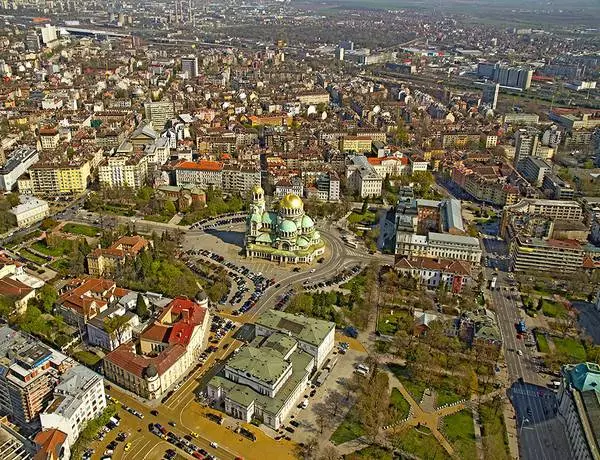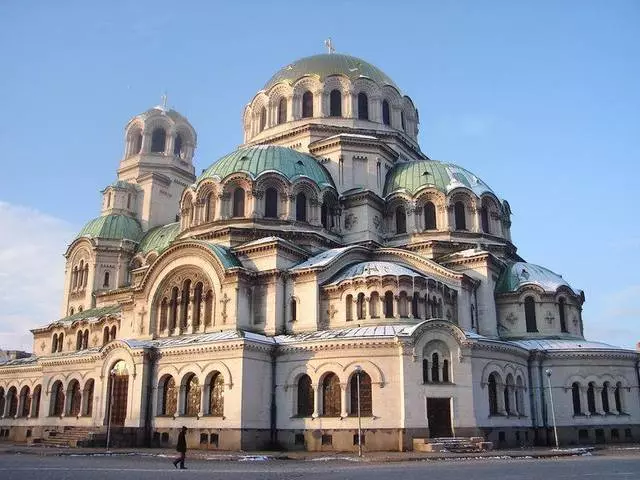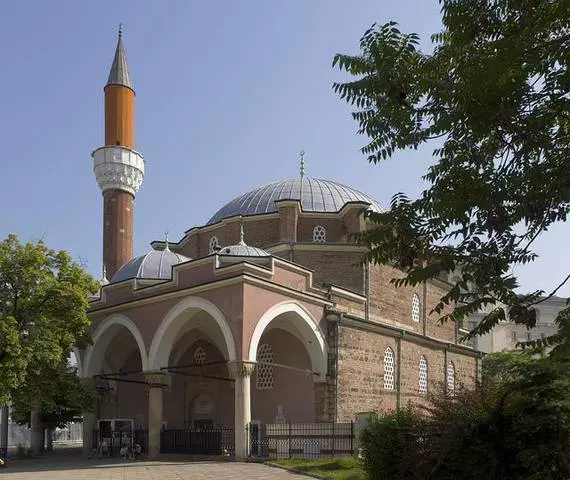Sofia is one of the most vintage European cities, where excellent examples of church and historical architecture were saved to this day. Despite the fact that Sofia became the capital not so long ago - no more than a century ago - it remains curious for tourists the center of culture, the place of mixing of the cultures of the East and Europe, as well as the city, filled with energy, contrasts and beauty.
We are known to us as the capital of the state, but, in addition, there are twenty-four districts in this city, large areas of the city. In Sofia, there is a full-blooded life, in the atmosphere of the city, the many ideas are hung - both old and new ones, and all this happens against the background of the picture of the unique wealth of history. Locals, fortunately for tourists, are able to maintain memory of the past times.
Panorama Sofia:

What can I see in Sofia? Most of the tourist routes start from building Temple - Monument of St. Alexander Nevsky . On the Square of the People's Assembly Tourists will curious to look at the structure National Assembly with located there The figure of Emperor Alexander Second . While walking Boulevard Tsar Liberator You can Monster Russian Church of St. Nicholas and Museum of Natural Sciences And to be W. Square Batemberg which is known as the city center.
Building Cathedral of St. Alexander Nevsky Located in 3170 square meters, it is designed for five thousand parishioners. The facade of the building is fully lined with a white stone, and the doors at the entrance are made of Slavonic oak. Cathedral domes are covered with gilding. The bell tower has a height of fifty-three meters. It is located twelve bells on it, the weight is most severely in twelve tons, and the easiest - only ten kilograms. The ringing of bells is spread over a distance of fifteen kilometers. The temple has a unique interior, he produces a powerful impression due to its wonderful decorations from marble, as well as wall-mounted and icons - all of them are eighty-two. They were written by Czech, Bulgarian and Russian artists. The most impressive tourists marble iconostasis, the thrones - the royal and patriarch, as well as the Ambon. Also here is located a mosaic panel, where you can see the image of the king Ferdinand and the queen Eleanora.
Since 1946, two holidays celebrate in the cathedral: the twelfth of September - the transfer of the relics of St. Alexander Nevsky from Vladimir to St. Petersburg, and the twenty-third of November - the day of the Assumption of St. Alexander Nevsky.
In the temple dungeon there is Crypt, which is a collection of icons, among which there are many masterpieces of icon painting. Since St. Alexander Nevsky Cathedral is a monument, he does not have a certain arrival. In this cathedral, there are daily, Sundays and festively public servants, but they do not conduct christening, weddings and funerals. The exceptions of this rule were only the wedding of the king Boris Third, who was on the throne in 1918 - 1943. - It was in 1930 - m, he married Princess Giovanna Savoy, then holding his funeral - in 1943, and also the funerals of Patriarch Kirill - in 1971 - and the famous opera singer Boris Christova - in 1993 - m .
Church of St. Alexander Nevsky - the second largest Orthodox cathedral in the Balkans.
Church of St. Alexander Nevsky:

The best shops in the city are located in Vitosha Boulevard, and in addition - are located in the gallery located near the National Palace of Culture. Tourists are probably interested in the only mosque in Sofia, which was erected at the end of the sixteenth century Turkish architects of Mamar Mamar Sinan. Another building is an architectural monument that relates to his merits is the Mosque of Selim's second, which is located in Edirne. The building erected in Sofia is named Mosque Banya Bashi . In the back of the building there is a small, not so long ago found fragment of the ancient bath, which was previously adjacent to the mosque, as well as a fountain with drinking hot water. You can only visit the building only when the parishioners do not make Namaz.
Bay Bay Mosque:

Another memorable place in the city that has the word "bath" in its name is Mineral (or Turkish) bath which was built at the beginning of last century. This construction is really pearl of the architectural art and the historic attraction of Sofia. Beautiful facade of the building and ceramics design contains a message to the ornaments inherent in the churches of the city of Nessebar of the Middle Ages. In the nineties, in severe for Eastern European states, this structure, as neither sad, was forgotten by the authorities and for almost twenty years work on reconstruction continues. In the future, the power of the city intends to open the museum in this place.
In the central part of a small Banski Square That is located between the Banya Bashi Mosque and Mineral Bath, there is a new fountain. And behind the mineral bath, an wonderful complex with fountains, of which the pit water beats were erected.
Other interesting places in Sofia are Mosque Buyuk - Jami, Church of St. Peter Samofratsky, National Archaeological Museum , as well as Church of the Holy Sedmochistnica.
Curious for tourists will also be Museum of the History of Sofia, Buildings of the Sofia University named after the Clement Orchid, City Picture Gallery what is in the Central Park, as well as Sophia Mineral Baths who are erected at the place where the Roman term was located before.
IN National Museum of History You can fully learn about the traditions of the Bulgarian people, here is a wonderful set of exhibits. This cultural institution was founded not so long ago - in 1981 - m, then the 1300th anniversary of the statehood of Bulgaria was noted with a scope. The legends of the legends of Thracian gold put out that tourists could look at each exhibit separately. Other exhibition objects, ceramics, bas-reliefs and silver - allow you to get acquainted with local achievements during the Middle Ages. For example, here there are a large number of artifacts related to the period of the Bulgarian Renaissance - there are also folklore suits, decorations and items used in everyday life.
